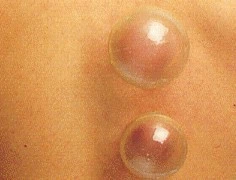What is Cupping...? and other techniques "acupuncturists" use
The life of an acupuncturist involves, among many other things, being a person with answers. The world is still learning about acupuncture and, consequently, people have many questions. The usual ones such as "do the needles hurt?", "does it work?", "what can you treat?" are relatively easy - just "no", "yes", and "everything".... If only it was all that easy!
What "acupuncture" is, is often more than people realize. People generally understand that acupuncturists use needles, but that is only a part of the techniques they utilize. Acupuncturists are really Doctors of Chinese Medicine - they generally go to 4 years of graduate school, they do clinical rotations before leaving school, they are well versed in all aspects of Chinese Medicine along with the general concepts of Western Medicine. In short they are more than, simply "acupuncturists".
In practice "acupuncturists", use the full range of Chinese Medicine techniques when treating their patients. Treatments may include the use of Chinese Herbal Medicine (both internally and externally), Tuina (Chinese Massage), Medical Qi Gong (Energy Work), Moxibustion (an herb, ai ye (mugwort), that is burnt near the skin for certain conditions), Cupping (a technique which quickly loosens very tight muscles and is useful for removing toxins from the body), and others...
Each of these techniques has its place and some are used more than others. In this article, I am going to introduce a very valuable technique, cupping.
What is cupping?
Cupping, simply put, is akin to receiving a few of the deepest massages you've ever had, but done more gracefully, and in 5-7 minutes during a single treatment. Cupping is a tremendously helpful technique for pain cases as well as many other conditions. When combined with acupuncture and massage, the use of cupping will often cut down the number of treatments required for alleviation of pain by 30-70% in my experience.
The general idea is that stagnation of circulation in the muscles and body tissues will lead to pain and other illnesses. Cupping improves the circulation in these areas and pain is alleviated and underlying health issues are often helped. Cupping helps such issues as generalized pain, injuries of the back/shoulders/neck, etc., herniated discs, disc degeneration, arthritis, and other conditions such as asthma, colds and flus, insomnia, etc.
What does it involve?
 Cupping involves the application of glass or plastic cups which adhere to the body through the use of a pump or by heat (see illustration). The most common method is by heat, which is done by waving a burning cotton ball that had been soaked in alcohol through the cup quickly to create a vacuum. You do not feel the heat, but you will feel the cup pull up on the skin. The cups are used over certain acupuncture points and/or over areas of pain.
Cupping involves the application of glass or plastic cups which adhere to the body through the use of a pump or by heat (see illustration). The most common method is by heat, which is done by waving a burning cotton ball that had been soaked in alcohol through the cup quickly to create a vacuum. You do not feel the heat, but you will feel the cup pull up on the skin. The cups are used over certain acupuncture points and/or over areas of pain.
Once the cups are attached, they are generally left on for 5-15 minutes and are removed by simply pressing down on the skin and letting the air out. They do leave a mark on the body which lasts for about 4-10 days depending on the condition. The mark is very useful as a diagnostic tool - the darker the mark, the more stagnation there is in the muscles. As the marks lighten through progressive treatments, it is a sign that the underlying conditions are improving.
More detailed descriptions of usages for cupping and related techniques may be found within our Japanese acupuncture section in our Cupping (Kyukaku) article.
tag @yinyanghouse for questions/comments
Comment by Archived User
I ask those with experience and specialists to explain how cupping works in each of the different types (by explaining the theories) and what the therapist should avoid in some cases and some points.
Thank you, we always use you.
Comment by Chad Dupuis
There are entire books on the range of uses for cupping, along with when it shouldn't be used, etc. So providing all of that in a single comment would be difficult. Most of the general rules can be found in our Japanese acupuncture cupping section.
If there is anything lacking or that needs more clarification in the above referenced article, I would suggest asking more narrow/specific questions in our forums to have discussions about a particular point.